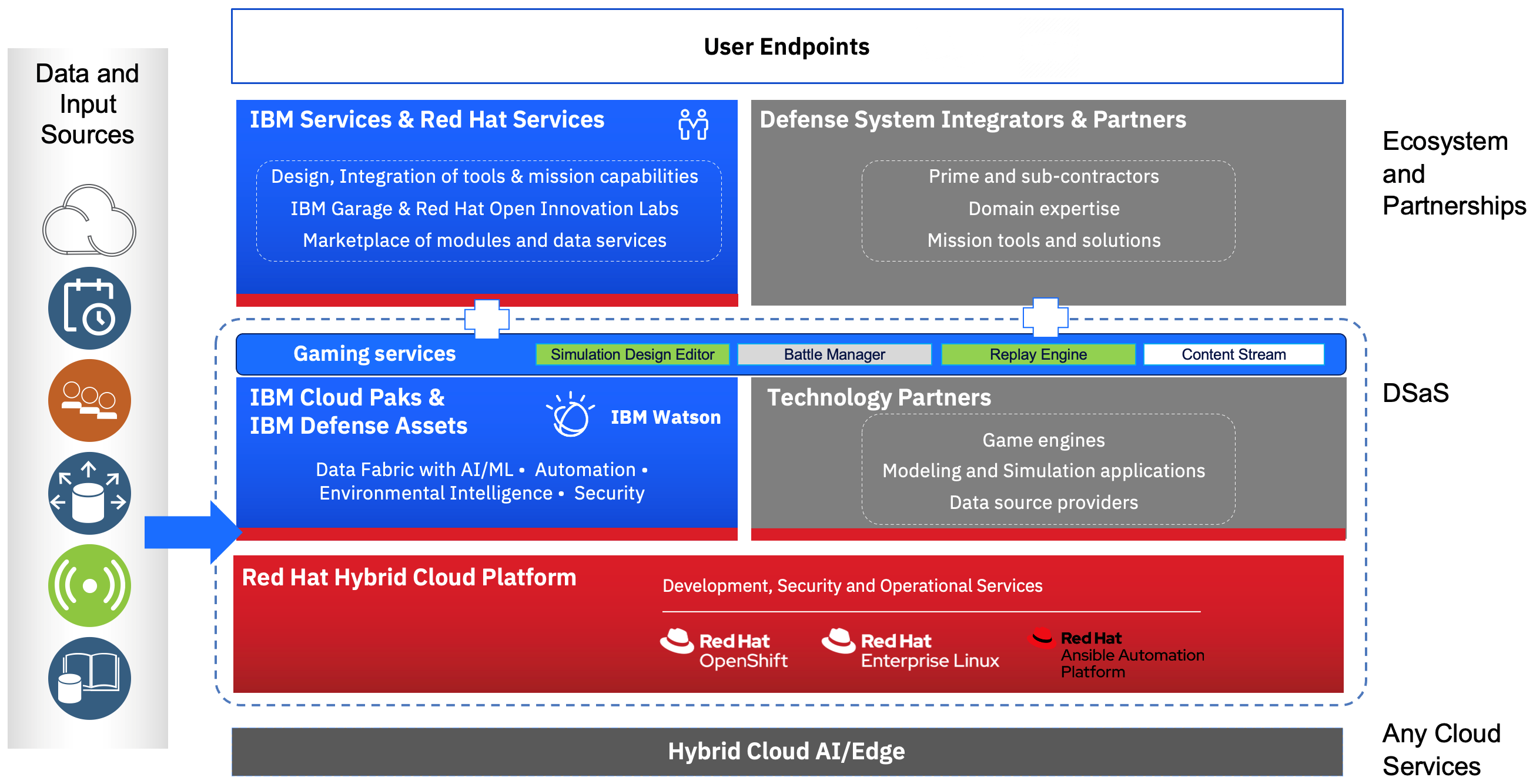Government
Defense Simulation Analytical Service
10 December, 2021 | Written by: Chris Nott, Stephen Gordon, and Leendert van Bochoven
Categorized: Government
Share this post:
The need for trusted decision making
IBM and Red Hat presented a concept demonstrator at last week’s I/ITSEC 2021 conference in Orlando. The Defense Simulation Analytical Service (DSaS) allows commanders in operations centers to make trusted decisions at the speed of relevance across air, land, maritime, space and cyber domains, based on open source information.
Understanding unfolding events in real time is an increasing priority for defense departments as adversaries employ techniques that span domains in novel ways, including the influencing of populations.
Modeling and simulation of scenarios for how events are likely to unfold is invaluable insight that can significantly improve command and control decisions. However, many tools in this field are siloed and thus frustrating analysts’ efforts. The challenges are: difficulty accessing data for modeling, inability to provisioning the most appropriate tools and lack of interoperability to integrate them in the moment.
A platform for many scenarios
IBM’s DSaS is an open source software platform built on Red Hat OpenShift that presents capabilities from an ecosystem of providers – both industry and defense – to analysts in a marketplace that can be assembled to support a wide range of scenarios. OpenShift allows those capabilities to run on any cloud infrastructure provider, on premises and out to the edge. This offers scale and global reach to support operations in contentious scenarios wherever they are in the world.

Figure: The Defense Simulation Analytical Service
At I/ITSEC, we demonstrated DSaS supporting a game for a scenario in Ukraine developed by Dr. Frederick W. Kagan of the American Enterprise Institute drawing on the work of the Russia Team of the Institute for the Study of War. The scenario recognises the importance of an additional information domain. The information domain includes news, social media et al with origin and intent. Having associated indicators and warnings is now essential to understanding the likelihood of offensive operations rather than relying only on traditional indicators in the physical domains.
DSaS presents information to analysts in various integrated views using artificial intelligence (AI) and machine learning (ML) to provide prioritised insights with confidence scores where appropriate and explainability of assertions back to their sources. It does not prescribe full automation: analysts can explore what they see and data behind it, adjust indicators and warnings, and model scenarios.
Data sources are fed into a data fabric. Three global services that IBM offers are news, geospatial representation of weather and threat analysis. The data fabric uses IBM’s Cloud Pak for Data running on Red Hat OpenShift and provides information governance services and a catalogue to enable easy access to data for other tools.
For example, DSaS offers capability for live monitoring such as video analytics from cameras prioritised using AI. Another example is that models can help detect misinformation and an analyst can teach the system to improve accuracy. We combine the location and movement of physical assets with news, misinformation and cyber activity, just one way that we offer analysts a cross-domain perspective. They can not only see the current situation but use timeline analysis for historical exploration and projection using AI.
IBM is drawing on experiences from other industries for gaming services. In this case techniques are adapted from sports and entertainment such as maximising team performance in fantasy football.
The marketplace presents tools and data services to analysts. They can provision the services they need by drag and drop. These services can be developed by defense departments themselves, incorporate mission tools from defense integrators and tools from technology partners. Such agility and interoperability is possible because of open architecture and standards (based on Red Hat OpenShift).
Whilst DSaS allows exploration of data, composition and experimentation for analysts, commanders are presented with a top-down view, a summary from which they can drill into the detail as needed. Analysts and commanders can collaborate, for example marking out areas of particular interest, to improve understanding and make better decisions. The service has algorithms to make recommendations for tasking and action which are in context and prioritised with confidence scores. Furthermore, DSaS encourages analyst feedback on insights presented and recommendations to help the service learn and improve. Overall, the service presents capabilities selected by individual analysts to support their own workflows.
IBM and Red Hat are collaborating with clients in individual nations and business partners to develop this into a service-based platform in line with NATO’s Modeling & Simulation as a Service concept. We address the need in a multi-domain, complex-dilemma environment for near peer adversarial or low intensity conflict scenarios. The technology allows analysts to visualise varying conditions to take advantage of opportunities with speed and precision.
DSaS is a concept created by the authors. Please contact one of us on our social channels or directly for further detail.

Global Technical Leader for Defence & Security

Director Business Development, Defense & National Security, Red Hat

Global Lead for Defence and Intelligence Global Markets
Navigating complexity: powering better-informed decision making with Improbable Defence’s Skyral and IBM’s DSaS
Our lives are defined by unprecedented volumes of data. Massive data – what we used to call ‘big data’ – has propelled us into The Information Age and continues to drive unprecedented technological innovation. It’s transforming how we live, connect and operate. Here’s one example. The Information Age has accelerated an unfortunate but perhaps inevitable […]
Embedding analytics and AI in mission command
Defence chiefs are grappling with how to apply analytics and artificial intelligence (AI) for decision advantage knowing that commercial sectors already benefit. In particular, responding to activities designed by adversaries to coerce without military conflict and assist in decision making to act on specific operational problems. A study by IBM’s Institute for Business Value last […]
Defense Simulation Analytical Service
The need for trusted decision making IBM and Red Hat presented a concept demonstrator at last week’s I/ITSEC 2021 conference in Orlando. The Defense Simulation Analytical Service (DSaS) allows commanders in operations centers to make trusted decisions at the speed of relevance across air, land, maritime, space and cyber domains, based on open source information. […]


